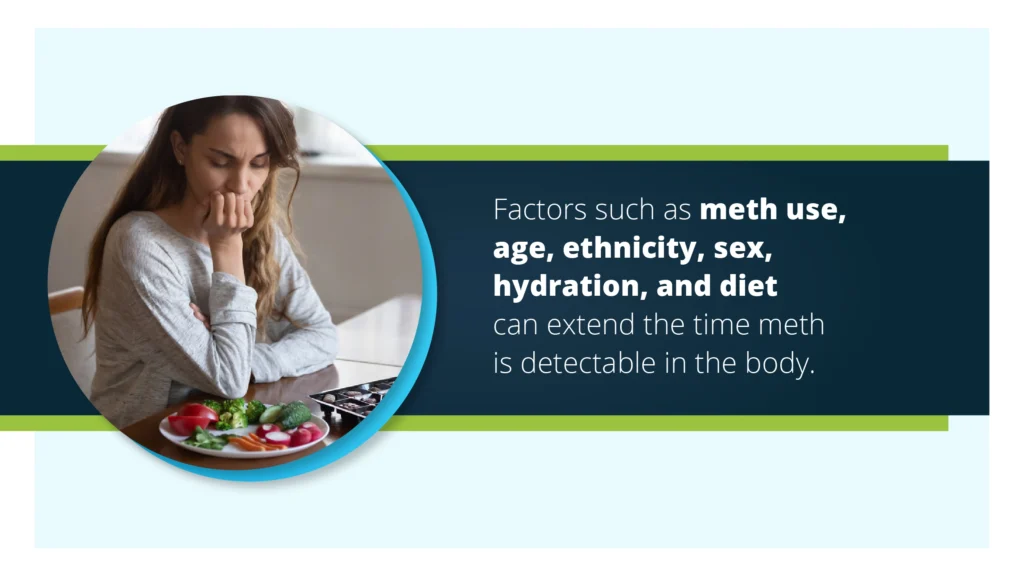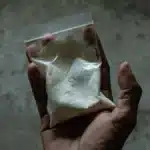Methamphetamine, commonly known as meth, can linger in your system for a while. But for how long? This guide will shed light on the duration meth remains detectable in your body. We’ll explore factors influencing this timeline, providing clear insights into how long your detox might last.
So, let’s dive in and unravel the mysteries surrounding the duration of meth in your system.

Key Takeaways
Methamphetamine, or meth, has an average half-life of about 10 hours in the body, meaning it takes ten hours for half of the substance to be eliminated. Here’s what you need to know:
- Different types of drug tests have varying detection windows for meth: urine tests (2-5 days), blood tests (1-3 days), hair tests (up to 90 days or more), and saliva tests (1-2 days).
- Factors such as meth use disorder, age, ethnicity, sex, hydration, and diet can extend the time meth is detectable in the body.
- Meth addiction treatment involves detoxification, behavioral therapy, medication-assisted treatment (MAT), and a supportive environment.
- Recovery from meth addiction is a long process, and seeking medical attention during recovery is essential to address potential health issues.
At The Haven Detox-Little Rock, we’re committed to providing you with the support and guidance you need on your journey to recovery. Join our compassionate and experienced team to take the first step towards a substance-free future. Contact us at (501) 271-3342 today.
How Meth Metabolizes
Methamphetamine, also referred to as crystal meth, is a strong substance that affects people differently. When a person uses meth, their body begins to process the drug. The average half-life of meth in the body is around 10 hours, which means it takes this long for half of the substance to be eliminated.
Meth can be detected in drug tests for several days after its last use. Different tests, like urine and blood tests, can reveal traces of the drug. Hair follicle tests can even show meth use over a longer period.
Understanding how long meth stays in the human body system is crucial, especially when considering withdrawal symptoms and seeking professional help. If you or someone you know is struggling with meth addiction, treatment programs and medical supervision can be effective options. Regular testing can help monitor progress towards a substance-free life.
How Long Meth Can Be Detected
Different types of drug tests can detect methamphetamine use, each with its own detection window. Here’s what you need to know:
- Urine Tests: These are the most common tests and can detect meth for up to 2-5 days after use.
- Blood Tests: They can identify meth in the bloodstream for about 1-3 days.
- Hair Tests: Hair tests can show traces of meth for up to 90 days or more.
- Saliva Tests: Saliva tests can detect meth for 1-2 days after use.
The detection time varies based on factors like the type of drug test, the frequency of use, the amount of meth used, and an individual’s metabolism.
Understanding how long meth can be detected is essential for addiction treatment and recovery. After long-term use, it may take a while for a negative drug test result, but with the right help and support, recovery is possible.
Factors that Prolong Meth Detection
Understanding the factors that can extend the detection of meth in your system is essential. Here are some key aspects to consider:
Meth Use Disorder
When someone struggles with meth use disorder, it’s harder for their body to remove meth. Long-term use alters brain chemistry, leading to addiction. Overcoming this disorder requires professional support through detox and therapy.
Age, Ethnicity, and Sex
Age, ethnicity, and sex can influence how long meth stays in the body. Younger individuals might process meth differently. Additionally, biological differences due to race and sex can impact drug metabolism.
Hydration and Diet
Hydration and a balanced diet play a significant role in meth detection. Drinking water and eating healthy foods may help flush meth out of the system faster. But if a person is dehydrated or has a poor diet, meth might stay longer in their body.
Treatment for Meth Addiction
Meth addiction can be challenging, but there are effective ways to overcome it. Here are some key factors to consider:
Detoxification
The initial phase of meth addiction treatment involves detoxification, a critical step in ridding the person’s body of the drug. This process can be challenging, typically lasting a week or sometimes even longer. The duration of detoxification varies from person to person, primarily depending on individual differences in metabolism.
Some individuals may clear meth from their system more quickly, while others may require an extended period for a complete detox, ensuring they are free from the drug’s influence and effects.
Behavioral Therapy
Individual and group therapy are vital components of meth addiction treatment. In these therapy sessions, individuals receive the emotional support they need to cope with the psychological effects of meth use. These effects often include severe cognitive impairments, affecting memory, decision-making, and overall mental health.
Additionally, specialized treatment is sometimes necessary to address these cognitive challenges effectively. Through these therapeutic approaches, individuals can work toward regaining their cognitive function and emotional well-being, ultimately aiding in their recovery from meth addiction.
Medication-Assisted Treatment (MAT)
Medication-Assisted Treatment, often referred to as MAT, is a valuable approach in the battle against meth addiction. It involves the use of specific medications to reduce cravings and ease the withdrawal symptoms associated with methamphetamine use. These medications, when administered under the supervision of medical professionals, can make the recovery process more manageable.
By diminishing the intense urge to use meth, MAT allows individuals to focus on therapy and rehabilitation, providing a more comprehensive and holistic approach to breaking free from the grip of addiction.
Supportive Environment
A supportive environment can make all the difference in a person’s journey to recovery from meth addiction. It provides a safe and understanding space where individuals can share their challenges, fears, and triumphs. Friends, family, and support groups play a vital role in this process, offering encouragement and a network of people who genuinely care.
Ongoing support ensures that those in recovery have access to help whenever they need it, reducing the risk of relapse and fostering a sense of community that reinforces their commitment to leading a healthier, drug-free life.
Moreover, recovery from meth addiction is a long process. It’s important to understand that it may take time, and relapses can occur. Treatment for meth addiction has improved in recent years, considering individual differences and the use of MAT. Seeking medical attention during recovery is essential. Meth addiction can lead to various health conditions, and it’s crucial to address them.
Frequently Asked Questions (FAQ)
The duration meth stays in your system depends on several factors, including the frequency and duration of use, the person’s metabolism, and the type of drug test used. For example, urine samples can detect meth for 2-5 days after use, while hair tests may reveal it for up to 90 days.
Meth withdrawal and substance use disorders can also influence the time it remains in your body. Other factors like physical activity, higher doses, and individual needs play a role in the detection window. Understanding these various factors is essential when considering treatment options and recovery from meth abuse.
The duration that meth stays in someone’s system can vary based on several factors. Typically, meth can be detected in urine for 2-5 days, in blood for 1-3 days, and in hair follicles for up to 90 days or more.
The exact time may depend on the individual’s metabolism, the amount used, and the frequency of use. Understanding the various factors influencing detection time is important, especially when considering recovery from meth use.
Methamphetamine can typically show up in urine for about 2-5 days after use. However, the exact duration can vary based on factors like the individual’s metabolism, the amount of methamphetamine consumed, and the frequency of use.
It’s important to note that drug detection times in urine can differ from person to person, so this is a general estimate. Understanding these factors is crucial when considering drug testing or addressing issues related to methamphetamine use.
Start Your Comeback Story at The Haven Detox-Little Rock
If you or a loved one are struggling with methamphetamine use and need help on your journey to recovery, The Haven Detox-Little Rock is here for you. Our comprehensive services include detox, residential treatment, and support for a wide range of substance use disorders, including alcoholism, cocaine, heroin, and meth addiction. We understand that each person’s path to recovery is unique, and we’re dedicated to providing personalized care and guidance. Take the first step towards a healthier, brighter future by contacting The Haven Detox-Little Rock at (501) 271-3342 today.



